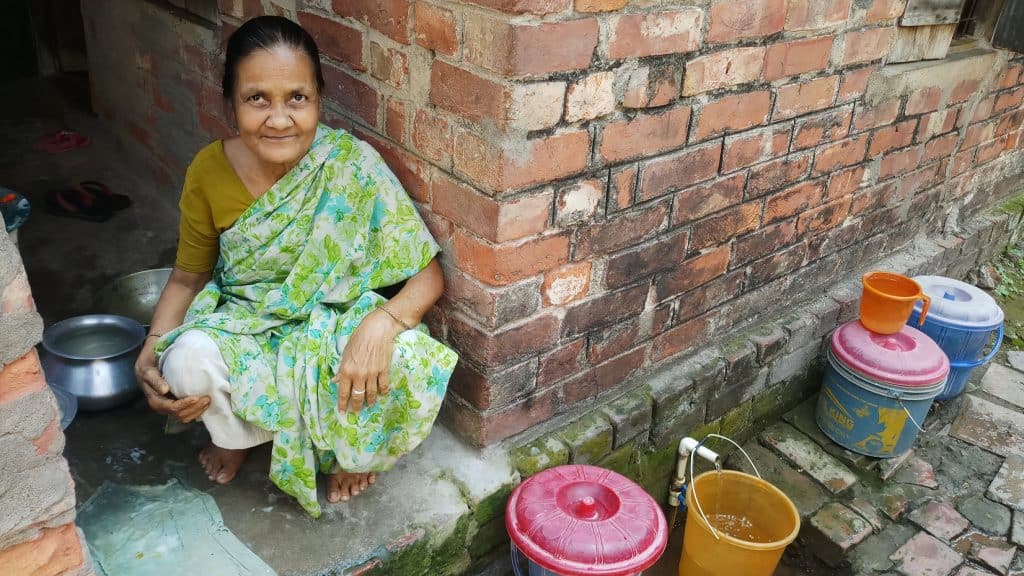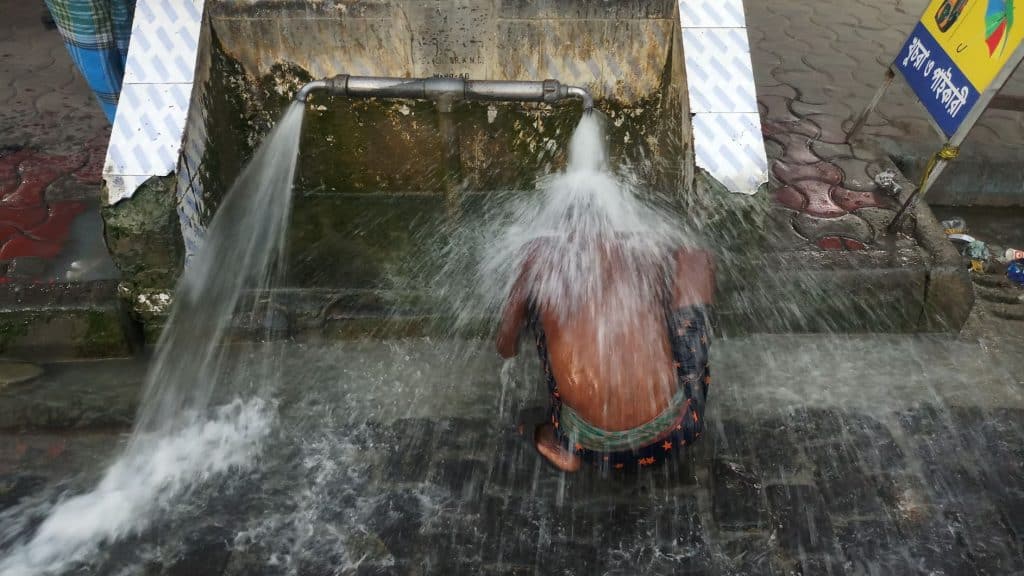The weather is sultry and the temperature is scorching in the Raipur locality of Jadavpur, off South Kolkata. The furnace-like conditions have forced residents to stay indoors. But Meena Nag is unmindful of the heat and is getting ready to wash a bucket full of clothes near a pond in the locality.
The 60-plus woman says that water supply is often erratic in the locality and the low pressure of water in the taps means it takes a long time for the bucket to get filled up, causing long queues that often end in mild altercations. “We face water crisis during summers when the taps sometimes run dry or have a low flow of water. We then have to depend on the pond for taking baths or washing clothes and utensils. The state government should ensure that citizens do not suffer from water crisis,” she says as she sets off to fetch a bucket of water from the pond despite her advancing age.
Even the local councillor of ward number 99, where Meena resides, concedes that most parts of south Kolkata are reeling under a water crisis because of the excessive dependence on groundwater and inadequate supply of water from Kolkata Municipal Corporation (KMC) that covers 144 wards in the city.
“It is true that ground water level in my ward and in other localities have gone down because of excessive extraction by the households and new high rises coming up in the city,” said Debasish Mukherjee, the KMC councillor, adding that the situation is such that taps have been built below the surface because the pressure is too low to lift the water up in some of the areas. “I have urged the KMC officials to build a water reservoir in every ward to store the water from Garden Reach pumping station before it is supplied to the residential houses. It would decrease dependency on ground water but nothing has been done so far,” he said.
The water crisis has boosted the business of mineral water suppliers who have been minting money at the expense of people’s woes, “We are forced to spend Rs 3000 every month on mineral water because the groundwater is not of good quality and has high levels of iron and arsenic, while the fresh water supplied is not enough to fulfil our needs. The candidates of all political parties make false promises of working to improve the condition, but nothing has been done and the problem persists. People should decide wisely and vote for candidates who seem to be genuinely concerned about the issues we face every day,” said DN Mazumdar, a retired government employee who lives in the same ward.

Meena Nag points to the trickle from her tap and says it’s just not enough for her household needs. Pic: Gurvinder Singh
Serious implications
Experts say that fast depletion of groundwater might have far more dangerous consequences than the common perception that Kolkata might face acute water shortage in the near future. Dr P K Sikdar, researcher and acting Registrar at the Indian Institute of Social Welfare and Business Management (IISWBM) who has also authored five books on environment, points out “Groundwater (availability) is rapidly shrinking in the city. It might lead to land subsidence as there is a layer of around 40 metres of clay underground and then sand that might give away.”
Thus, groundwater levels dropping can result in sinking of the earth’s surface, leading to tilting or collapse of buildings. Sikdar adds, “The deepening of the ground water level would also hamper its quality and increase the cost of extraction.”
P K Sikdar has actually been researching the groundwater of West Bengal for more than thirty years now. He points out that the flow of water began to change from the late 1970s to early 1980s, when large scale extraction began: “Earlier, in the fifties, the groundwater used to flow from north to south but a change was noticed three decades ago when a groundwater pressure trough developed in the south central part of Kolkata city due to heavy groundwater abstraction and the water started flowing into the trough from all directions. This pressure trough then began to widen slowly and still persists today. The pressure troughs remain even after the monsoon, suggesting that the discharge has been more than recharge.”
He further said the ground water level that was more or less near the sea level has dropped drastically by 15 to 16 meters in the past five decades.
Contamination issues
A study by P K Sikdar and others has found that the city faces high levels of manganese and iron content in the groundwater which can cause serious ailments. Concentrations of manganese exceed 0.3 mg/L, which is the Indian permissible health guideline value for drinking water and going beyond which may adversely affect children in terms of memory, attention and motor skills. The concentration in the groundwater of the city supplied through municipal and public wells is as high as 1.4 mg/L in places.
As per Indian standards, the permissible limit of iron in the water should be less than 0.3 milligram per litre and even 1 milligram per litre is permissible where alternative sources of water are not available. However, in Kolkata’s groundwater, the iron content has been found to be much higher and even upto 23 milligram per litre in places.
High concentration of iron may lead to hemochromatosis damaging the liver, heart and pancreas, as well as diabetes, said Dr Sikdar. He, however, made it clear that barring some pockets in Tolly nullah area in the south, the city areas do not face serious threat of arsenic contamination.
But one need not go too far to witness the presence of arsenic contamination. Researchers at Chittaranjan National Cancer Institute (CNCI), Kolkata claim that low level arsenic (11-50 µg/L) found in the groundwater of the rural areas of North and South 24 Parganas and Nadia, approximately 80 kms from the city, could pose serious health hazards.
“We conducted tests on more than a thousand people and approximately 50% or even more were found to have molecular and cellular alterations which lead to aggravation of pulmonary and systemic inflammation. Chronic low arsenic exposure may lead to persistent inflammation which in turn may increase the vulnerability towards a vast array of inflammatory disorders, including cancer,” said Dona Sinha, Senior Scientific Officer at CNCI whose group has been conducting research on the health effects of low arsenic in rural pockets of Bengal since 2012.
Sinha laid stress on reducing the dependency on ground water as the only alternative to prevent the high intake of arsenic, “The authorities should decrease the excessive dependence on ground water by supplying fresh water in the outskirts. Even the reverse osmosis water cannot be a complete solution, as all households cannot afford it, especially those living in slums.”
Water supply in Kolkata
Dismissing allegations of water scarcity, officials of KMC say that they have been steadily supplying water to around 45 lakh residents of the city but the migrant population of 5 lakh approximately adds to the pressure, “The per capita requirement is 150 litres and we have been supplying 400 million gallons of water every day supplied from Tala, Gardenreach, Dhapa and Jorabagan pumping stations. We have to also deal with the floating population that enters and exits during office hours,” said BK Maiti, CEO, and ex-officio DG (Water Supply), KMC.
Kolkata officially has about 14,000 stand posts (as water hydrants, drawing water from the Ganges, are referred to in the city), 12,000 hand tube wells (hand pumps) and around 2,500 large tube wells mainly catering to multi-storied buildings, but the actual figures are far higher.

A person takes a bath at a public tap in North Kolkata. Water from the adjacent spout pours out needlessly and is wasted. Pic: Gurvinder Singh
Maiti indirectly hinted that abolition of water tax by the present regime has encouraged the wastage of water, “People normally tend to become careless towards the commodities that are free and they are mindful about those for which they have to cough up money. We have tried to monitor water meters in some pockets of the city but constant monitoring is required.”
Soon after coming to power, the state government led by Mamata Banerjee had abolished the collection of water tax in 2011. It crippled the revenue for municipal authorities and encouraged activities of private water suppliers. This triggered reckless and callous use of water has increased, creating inevitable pressure on groundwater. But the consequence of this is what citizens and authorities both need to wake up to, urgently.
| This article is part of a series produced under the Citizen Matters – Sustainable Cities Reporting Fellowship , supported by Climate Trends. |